Comprehensive mPoint: A Method for 3D Point Cloud Generation of Human Bodies Utilizing FMCW MIMO mm-Wave Radar
Abstract
:1. Introduction
- In this paper, a novel data processing method considering both the static and dynamic characteristics of radar reflected signals is proposed and utilized in order to generate the point cloud of the human bodies.
- The RDI is introduced to help reduce noise during the radar signal target detection process in order to improve the performance of angle estimation on MTI results. The optimized RAI is obtained.
- The optimized RAI is utilized to locate the target on the direct RAI from Range-FFT data. More detailed reflection information of detected target is obtained from the combined RAI.
- Both the azimuth and elevation angle information of the detected target from two combined RAIs are captured based on the corresponding range and SNR value in order to help generate the 3D point cloud of the target.
2. Background Theory and Proposed Method
- Detect the peak value of velocity in RDI and determine the distance R of the human target.
- Find the moving target information at R in the RAI from MTI result, which is represented by area A. Area A refers to an area in the Range–Angle plane where the moving target is located, such as the target area in the RAI.
- Corresponding to the target information in the RAI from MTI result, the data at the corresponding position (area A) in the direct RAI from Range-FFT data is used as the target data, which is . The set is a set of target points P on the angle plane, and it includes the distance, angle and signal-to-noise ratio values.
- After obtaining the target data on the azimuth plane and on the elevation plane, the point cloud of the target is finally produced based on the corresponding range and SNR value on different angle planes. The formula is given by the following:where represents the combination of target data in two different angle planes. The above algorithm process can be represented in the following pseudocode (Algorithm 1).
| Algorithm 1: Point Cloud Generation |
| FUNCTION Combined RAI Generation (data = Radar Raw Data): Range-FFT data = 1D FFT (data), RDI = 2D FFT (Range-FFT data) MTI result = MTI (Range-FFT data), RAI from MTI result = MVDR (MTI result) Direct RAI = MVDR (Range-FFT data) For d (range bin, velocity) in RDI: If d> SNR: range bin(d) ∈ speed change area If d in no speed change area: Optimized RAI = RAI from MTI result(d = 0) For d (range bin, velocity) in optimized RAI: If d > SNR: Combined RAI = Direct RAI (d) Return combined RAI combined RAI (azimuth), combined RAI (elevation) = Combined RAI Generation (data) For d1 (range bin, azimuth angle bin) in combined RAI (azimuth): If d1 > SNR: For d2(range bin, elevation angle bin) in combined RAI (elevation): If range bin(d2) = range bin(d1) And d2 = d1: Point cloud add p (range, azimuth angle, elevation angle, SNR) Return Point cloud END |
3. Experimental Implementation, Result and Discussion
3.1. Radar Sensor and Testbed Setup
3.2. Point Cloud Generation with Two Moving Targets and Discussion
3.3. Characteristics of the Generated Point Cloud and Discussion
4. Conclusions
Author Contributions
Funding
Institutional Review Board Statement
Informed Consent Statement
Data Availability Statement
Acknowledgments
Conflicts of Interest
Nomenclature
| FMCW | Frequency-Modulated Continuous Wave |
| MIMO | Multi-Input Multi-Output |
| Comprehensive mPoint | The point cloud generation method of millimeter wave radar proposed in this paper |
| TI-mPoint | The point cloud generation method of millimeter wave radar proposed in https://training.ti.com. Accessed 25 August 2021. |
| PIR | Passive Infrared |
| SAR | Synthetic Aperture Radar |
| FFT | Fast Fourier Transform |
| RCS | Radar Cross Section |
| Range-FFT | The FFT performed on the radar signal in the time domain data |
| MTI | Moving Target Indication |
| MVDR | Minimum Variance Distortionless Response |
| RAI | Range Angle Image |
| CFAR | Constant False Alarm Rate |
| RDI | Range Doppler Image |
| TDM | Time-Division Multiplexing |
| AOA | Angle of Arrival |
| SNR | Signal to Noise Ratio |
| DAQ | Data Acquisition Systems |
| FPGA | Field Programmable Gate Array |
| Doppler-FFT | The FFT performed on the chirps’ data |
| DBSCAN | Density-based Spatial Clustering of Applications with Noise |
| IQR | Interquartile Range |
References
- Lattanzi, E.; Dromedari, M.; Freschi, V. A Scalable Multitasking Wireless Sensor Network Testbed for Monitoring Indoor Human Comfort. IEEE Access 2018, 6, 17952–17967. [Google Scholar] [CrossRef]
- Antonucci, A.; Corrà, M.; Ferrari, A.; Fontanelli, D.; Fusari, E.; Macii, D.; Palopoli, L. Performance Analysis of a 60-GHz Radar for Indoor Positioning and Tracking. In Proceedings of the 2019 International Conference on Indoor Positioning and Indoor Navigation (IPIN), Lloret de Mar, Spain, 30 September–3 October 2019; pp. 1–7. [Google Scholar]
- Zhang, J.; Xing, M.; Xie, Y. FEC: A feature fusion framework for SAR target recognition based on electromagnetic scattering features and deep CNN features. IEEE Trans. Geosci. Remote Sens. 2020, 59, 2174–2187. [Google Scholar] [CrossRef]
- Shukri, S.; Kamarudin, L.M. Device free localization technology for human detection and counting with RF sensor networks: A review. J. Netw. Comput. Appl. 2017, 97, 157–174. [Google Scholar] [CrossRef]
- Bai, J.; Zheng, L.; Li, S.; Tan, B.; Chen, S.; Huang, L. Radar Transformer: An Object Classification Network Based on 4D MMW Imaging Radar. Sensors 2021, 21, 3854. [Google Scholar] [CrossRef] [PubMed]
- Trivedi, D.; Badarla, V. Occupancy detection systems for indoor environments: A survey of approaches and methods. Indoor Built Environ. 2020, 29, 1053–1069. [Google Scholar] [CrossRef]
- Song, H.; Yoo, Y.; Shin, H.C. In-Vehicle Passenger Detection Using FMCW Radar. In Proceedings of the 2021 International Conference on Information Networking (ICOIN), Hanover, Germany, 13–16 January 2021; pp. 644–647. [Google Scholar]
- Liu, J.; Mu, H.; Vakil, A.; Ewing, R.; Shen, X.; Blasch, E.; Li, J. Human Occupancy Detection via Passive Cognitive Radio. Sensors 2020, 20, 4248. [Google Scholar] [CrossRef] [PubMed]
- Mikkilineni, A.K.; Dong, J.; Kuruganti, T.; Fugate, D. A novel occupancy detection solution using low-power IR-FPA based wireless occupancy sensor. Energy Build. 2019, 192, 63–74. [Google Scholar] [CrossRef]
- Shami, M.B.; Maqbool, S.; Sajid, H.; Ayaz, Y.; Cheung, S.S. People Counting in Dense Crowd Images Using Sparse Head Detections. IEEE Trans. Circuits Syst. Video Technol. 2019, 29, 2627–2636. [Google Scholar] [CrossRef]
- Ren, P.; Fang, W.; Djahel, S. A novel YOLO-Based real-time people counting approach. In Proceedings of the 2017 International Smart Cities Conference (ISC2), Wuxi, China, 14–17 September 2017; pp. 1–2. [Google Scholar]
- Sun, S.; Akhtar, N.; Song, H.; Zhang, C.; Li, J.; Mian, A. Benchmark Data and Method for Real-Time People Counting in Cluttered Scenes Using Depth Sensors. IEEE Trans. Intell. Transp. Syst. 2019, 20, 3599–3612. [Google Scholar] [CrossRef]
- Ichige, K.; Saito, R.; Sugiyama, T.; Arakawa, N.; Kashiwagi, K.; Yuasa, A. Location Estimation Accuracy of Augmented Arrays for Millimeter-Wave FMCW-MIMO Radar. In Proceedings of the 2019 International Radar Conference (RADAR), Toulon, France, 23–27 September 2019; pp. 1–6. [Google Scholar]
- Huang, L.; Deng, X.; Zheng, L.; Qin, H.; Qiu, H. Joint Design of Colocated MIMO Radar Constant Envelope Waveform and Receive Filter to Reduce SINR Loss. Sensors 2021, 21, 3887. [Google Scholar] [CrossRef]
- Zhao, P.; Lu, C.X.; Wang, J.; Chen, C.; Wang, W.; Trigoni, N.; Markham, A. Human tracking and identification through a millimeter wave radar. Ad Hoc Netw. 2021, 116, 102475. [Google Scholar] [CrossRef]
- Nosrati, M.; Shahsavari, S.; Lee, S.; Wang, H.; Tavassolian, N. A concurrent dual-beam phased-array Doppler radar using MIMO beamforming techniques for short-range vital-signs monitoring. IEEE Trans. Antennas Propag. 2019, 67, 2390–2404. [Google Scholar] [CrossRef]
- Wang, Y.; Wang, W.; Zhou, M.; Ren, A.; Tian, Z. Remote Monitoring of Human Vital Signs Based on 77-GHz mm-Wave FMCW Radar. Sensors 2020, 20, 2999. [Google Scholar] [CrossRef] [PubMed]
- Santra, A.; Ulaganathan, R.V.; Finke, T. Short-Range Millimetric-Wave Radar System for Occupancy Sensing Application. IEEE Sens. Lett. 2018, 2, 1–4. [Google Scholar] [CrossRef]
- Vaishnav, P.; Santra, A. Continuous Human Activity Classification With Unscented Kalman Filter Tracking Using FMCW Radar. IEEE Sens. Lett. 2020, 4, 1–4. [Google Scholar] [CrossRef]
- Weiß, J.; Pérez, R.; Biebl, E. Improved People Counting Algorithm for Indoor Environments using 60 GHz FMCW Radar. In Proceedings of the 2020 IEEE Radar Conference (RadarConf20), Florence, Italy, 21–25 September 2020; pp. 1–6. [Google Scholar]
- Alizadeh, M.; Shaker, G.; Almeida, J.C.M.D.; Morita, P.P.; Safavi-Naeini, S. Remote Monitoring of Human Vital Signs Using mm-Wave FMCW Radar. IEEE Access 2019, 7, 54958–54968. [Google Scholar] [CrossRef]
- Stephan, M.; Santra, A.; Fischer, G. Human Target Detection and Localization with Radars Using Deep Learning. In Deep Learning Applications; Wani, M.A., Khoshgoftaar, T.M., Palade, V., Eds.; Springer: Singapore, 2021; Volume 2, pp. 173–197. [Google Scholar] [CrossRef]
- Gao, X.; Xing, G.; Roy, S.; Liu, H. Experiments with mmWave Automotive Radar Test-bed. In Proceedings of the 2019 53rd Asilomar Conference on Signals, Systems, and Computers, Pacific Grove, CA, USA, 3–6 November 2019; pp. 1–6. [Google Scholar]
- Cui, H.; Dahnoun, N. Human Posture Capturing with Millimetre Wave Radars. In Proceedings of the 2020 9th Mediterranean Conference on Embedded Computing (MECO), Budva, Montenegro, 8–11 June 2020; pp. 1–4. [Google Scholar]
- Li, G.; Zhang, Z.; Yang, H.; Pan, J.; Chen, D.; Zhang, J. Capturing Human Pose Using mmWave Radar. In Proceedings of the 2020 IEEE International Conference on Pervasive Computing and Communications Workshops (PerCom Workshops), Austin, TX, USA, 23–27 March 2020; pp. 1–6. [Google Scholar]
- Zang, B.; Ding, L.; Feng, Z.; Zhu, M.; Lei, T.; Xing, M.; Zhou, X. CNN-LRP: Understanding Convolutional Neural Networks Performance for Target Recognition in SAR Images. Sensors 2021, 21, 4536. [Google Scholar] [CrossRef]
- Lim, H.S.; Jung, J.; Lee, J.E.; Park, H.M.; Lee, S. DNN-Based Human Face Classification Using 61 GHz FMCW Radar Sensor. IEEE Sens. J. 2020, 20, 12217–12224. [Google Scholar] [CrossRef]
- Kang, S.-w.; Jang, M.-h.; Lee, S. Identification of Human Motion Using Radar Sensor in an Indoor Environment. Sensors 2021, 21, 2305. [Google Scholar] [CrossRef]
- Patra, A.; Geuer, P.; Munari, A.; Mähönen, P. mm-Wave Radar Based Gesture Recognition: Development and Evaluation of a Low-Power, Low-Complexity System. In Proceedings of the 2nd ACM Workshop on Millimeter Wave Networks and Sensing Systems, New Delhi, India, 29 October 2018; pp. 51–56. [Google Scholar]
- Toledo, F.; Delanoë, J.; Haeffelin, M.; Dupont, J.C.; Jorquera, S.; Le Gac, C. Absolute calibration method for frequency-modulated continuous wave (FMCW) cloud radars based on corner reflectors. Atmos. Meas. Tech. 2020, 13, 6853–6875. [Google Scholar] [CrossRef]
- Alizadeh, M.; Abedi, H.; Shaker, G. Low-cost low-power in-vehicle occupant detection with mm-wave FMCW radar. In Proceedings of the 2019 IEEE Sensors, Montreal, QC, Canada, 27–30 October 2019; pp. 1–4. [Google Scholar]
- Zhao, P.; Lu, C.X.; Wang, J.; Chen, C.; Wang, W.; Trigoni, N.; Markham, A. mID: Tracking and Identifying People with Millimeter Wave Radar. In Proceedings of the 2019 15th International Conference on Distributed Computing in Sensor Systems (DCOSS), Santorini, Greece, 29–31 May 2019; pp. 33–40. [Google Scholar]
- Zhao, Z.; Song, Y.; Cui, F.; Zhu, J.; Song, C.; Xu, Z.; Ding, K. Point Cloud Features-Based Kernel SVM for Human-Vehicle Classification in Millimeter Wave Radar. IEEE Access 2020, 8, 26012–26021. [Google Scholar] [CrossRef]
- Huang, X.; Cheena, H.; Thomas, A.; Tsoi, J.K.P. Indoor Detection and Tracking of People Using mmWave Sensor. J. Sens. 2021, 2021, 6657709. [Google Scholar] [CrossRef]
- Xue, H.; Ju, Y.; Miao, C.; Wang, Y.; Wang, S.; Zhang, A.; Su, L. mmMesh: Towards 3D real-time dynamic human mesh construction using millimeter-wave. In Proceedings of the 19th Annual International Conference on Mobile Systems, Applications, and Services, Virtual Event, WI, USA, 24 June–2 July 2021; pp. 269–282. [Google Scholar]
- Bao, Y.; Lin, P.; Li, Y.; Qi, Y.; Wang, Z.; Du, W.; Fan, Q. Parallel Structure from Motion for Sparse Point Cloud Generation in Large-Scale Scenes. Sensors 2021, 21, 3939. [Google Scholar] [CrossRef]
- Li, J.; Stoica, P. MIMO radar with colocated antennas. IEEE Signal Process. Mag. 2007, 24, 106–114. [Google Scholar] [CrossRef]
- Rajamäki, R.; Chepuri, S.P.; Koivunen, V. Hybrid beamforming for active sensing using sparse arrays. IEEE Trans. Signal Process. 2020, 68, 6402–6417. [Google Scholar] [CrossRef]
- Qiao, H.; Pal, P. Guaranteed localization of more sources than sensors with finite snapshots in multiple measurement vector models using difference co-arrays. IEEE Trans. Signal Process. 2019, 67, 5715–5729. [Google Scholar] [CrossRef]
- Sun, S.; Zhang, Y.D. 4D Automotive Radar Sensing for Autonomous Vehicles: A Sparsity-Oriented Approach. IEEE J. Sel. Top. Signal Process. 2021, 15, 879–891. [Google Scholar] [CrossRef]
- Patole, S.M.; Torlak, M.; Wang, D.; Ali, M. Automotive radars: A review of signal processing techniques. IEEE Signal Process. Mag. 2017, 34, 22–35. [Google Scholar] [CrossRef]
- Sengupta, A.; Jin, F.; Zhang, R.; Cao, S. mm-Pose: Real-Time Human Skeletal Posture Estimation Using mmWave Radars and CNNs. IEEE Sens. J. 2020, 20, 10032–10044. [Google Scholar] [CrossRef]
- Zhao, M.; Li, T.; Abu Alsheikh, M.; Tian, Y.; Zhao, H.; Torralba, A.; Katabi, D. Through-wall human pose estimation using radio signals. In Proceedings of the IEEE Conference on Computer Vision and Pattern Recognition, Salt Lake City, UT, USA, 18–23 June 2018; pp. 7356–7365. [Google Scholar]
- Reed, I.S.; Gagliardi, R.M.; Stotts, L.B. A recursive moving-target-indication algorithm for optical image sequences. IEEE Trans. Aerosp. Electron. Syst. 1990, 26, 434–440. [Google Scholar] [CrossRef]
- Capon, J. High-resolution frequency-wavenumber spectrum analysis. Proc. IEEE 1969, 57, 1408–1418. [Google Scholar] [CrossRef] [Green Version]
- Gandhi, P.P.; Kassam, S.A. Analysis of CFAR processors in nonhomogeneous background. IEEE Trans. Aerosp. Electron. Syst. 1988, 24, 427–445. [Google Scholar] [CrossRef]
- Ai, J.; Cao, Z.; Xing, M. An adaptive-trimming-depth based CFAR detector of heterogeneous environment in SAR imagery. Remote Sens. Lett. 2020, 11, 730–738. [Google Scholar] [CrossRef]
- Van Veen, B.D.; Buckley, K.M. Beamforming: A versatile approach to spatial filtering. IEEE Assp Mag. 1988, 5, 4–24. [Google Scholar] [CrossRef]
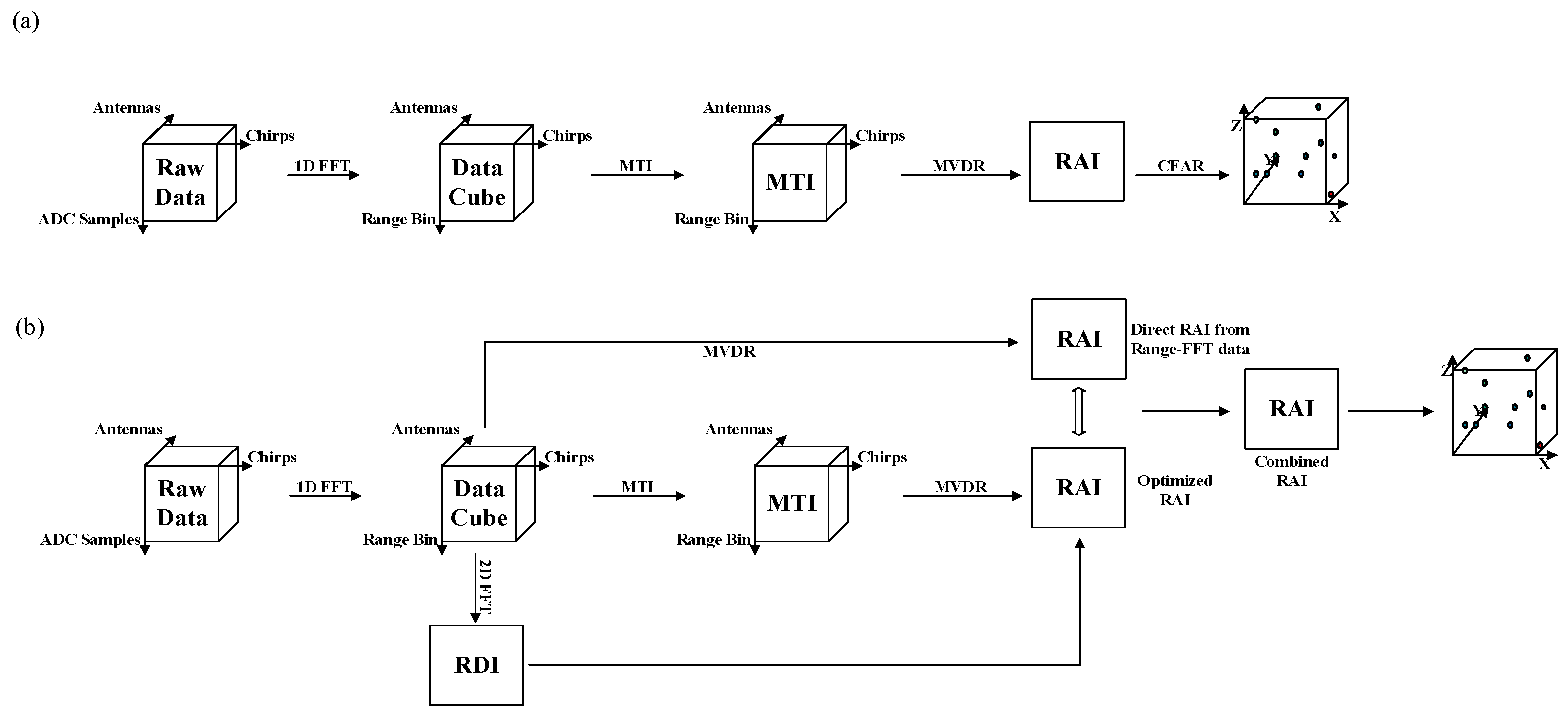
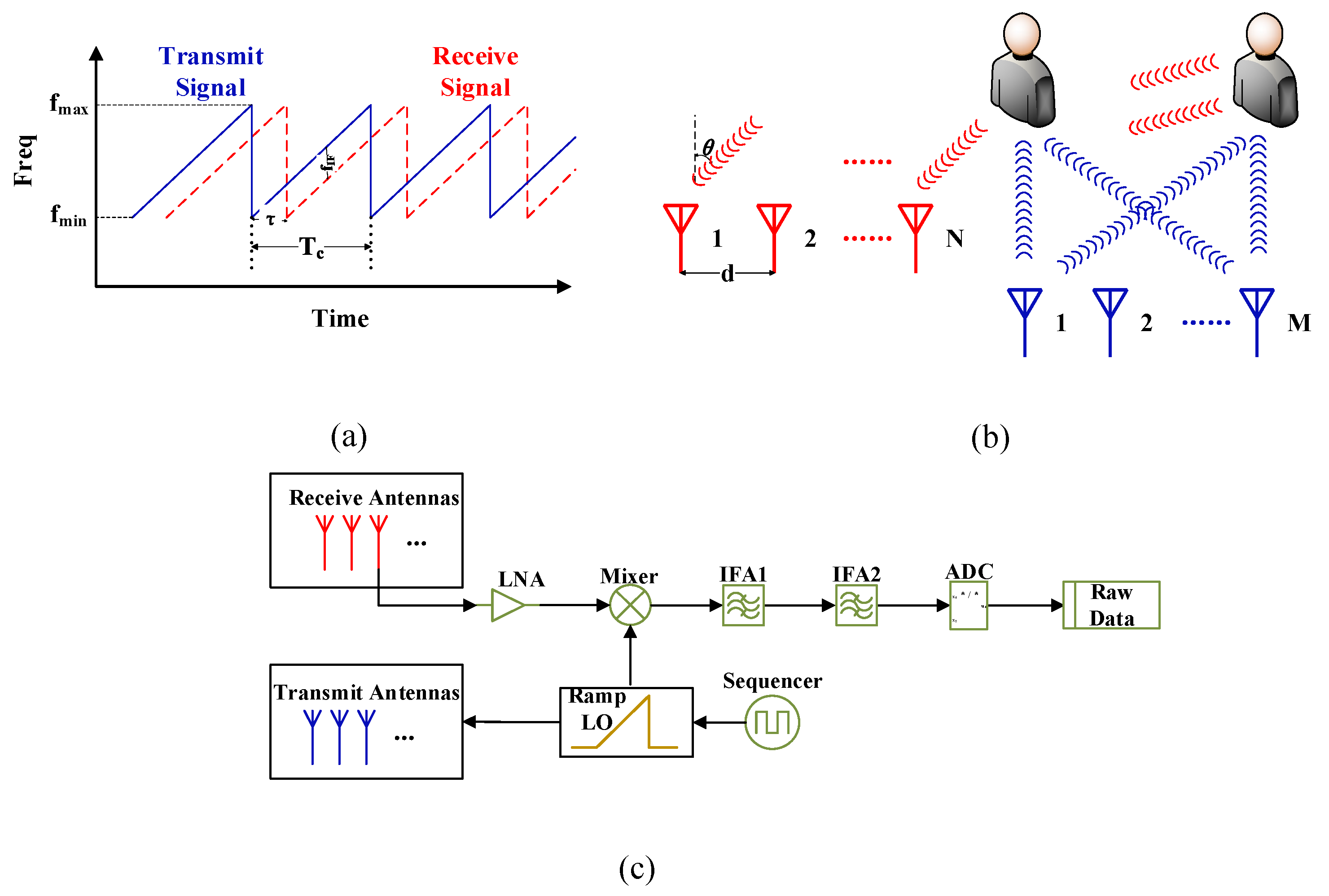
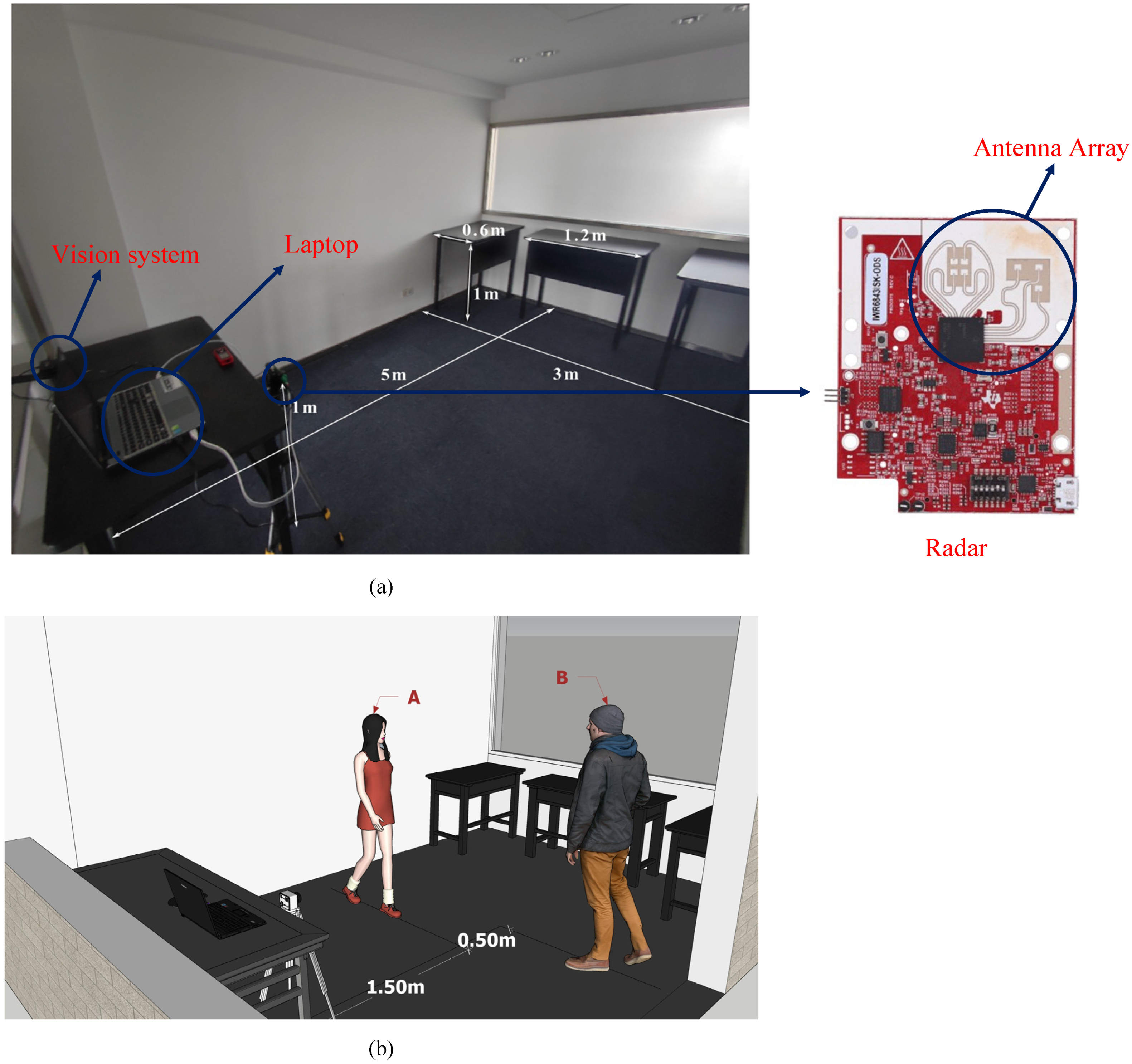
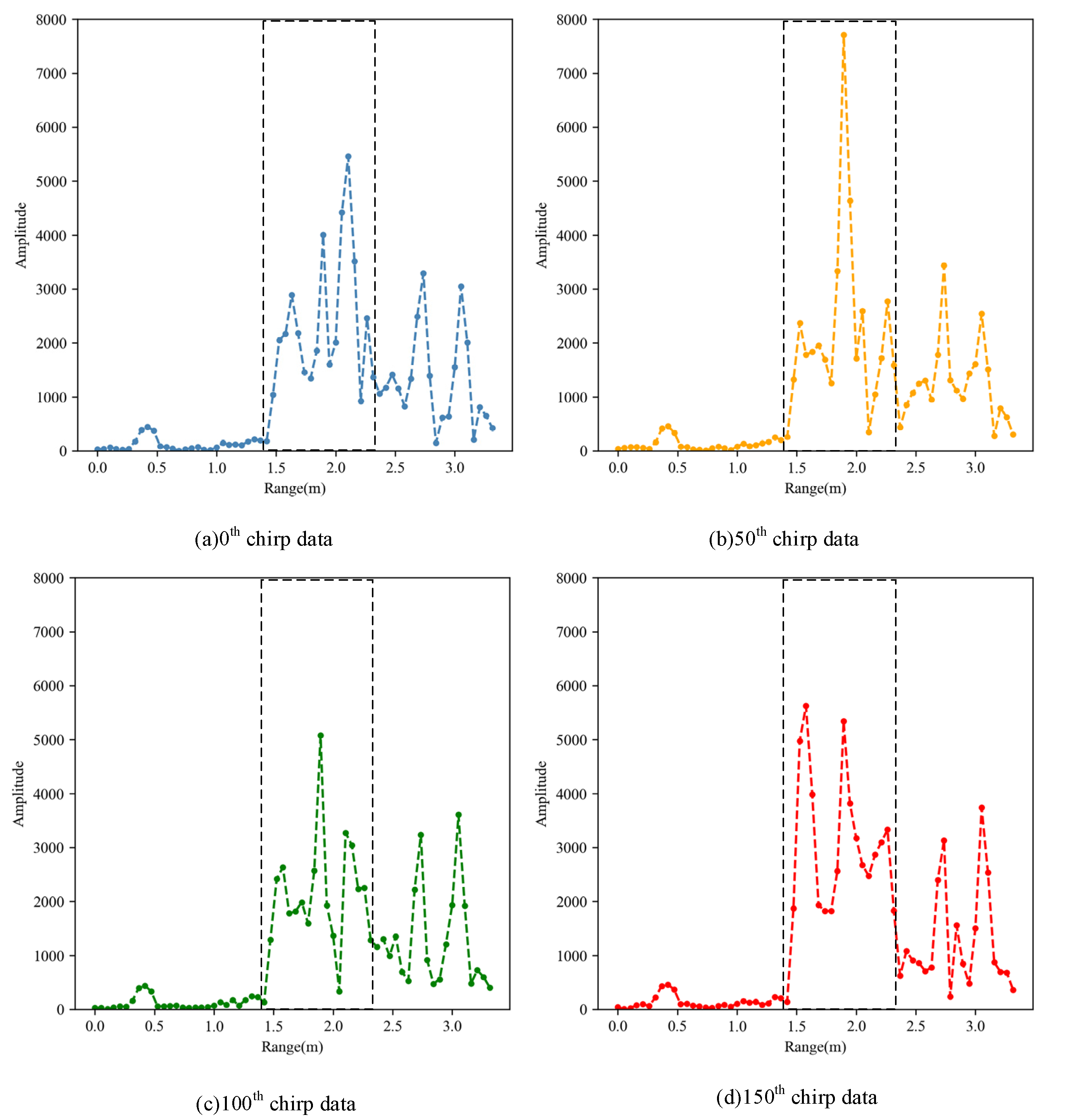
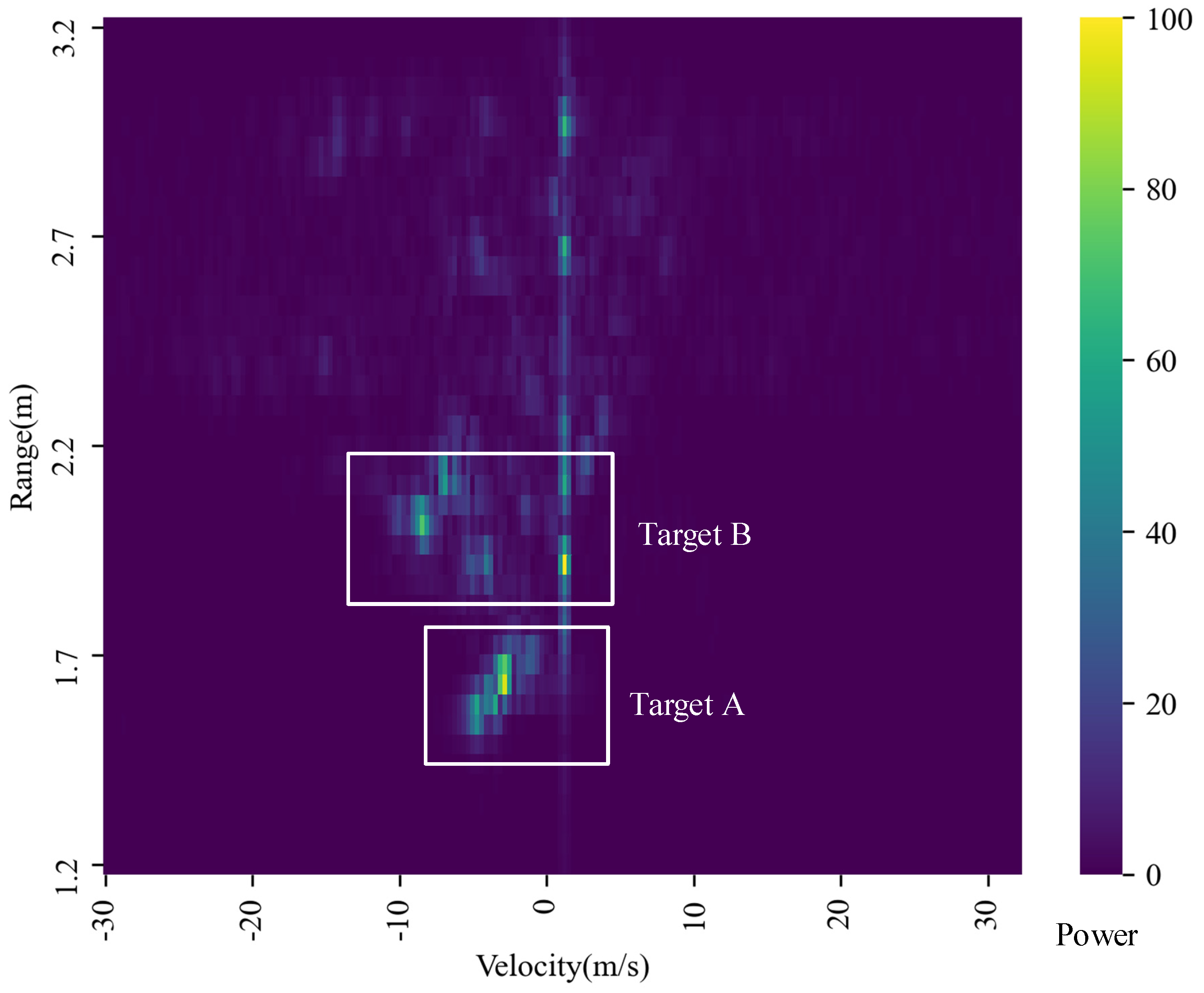
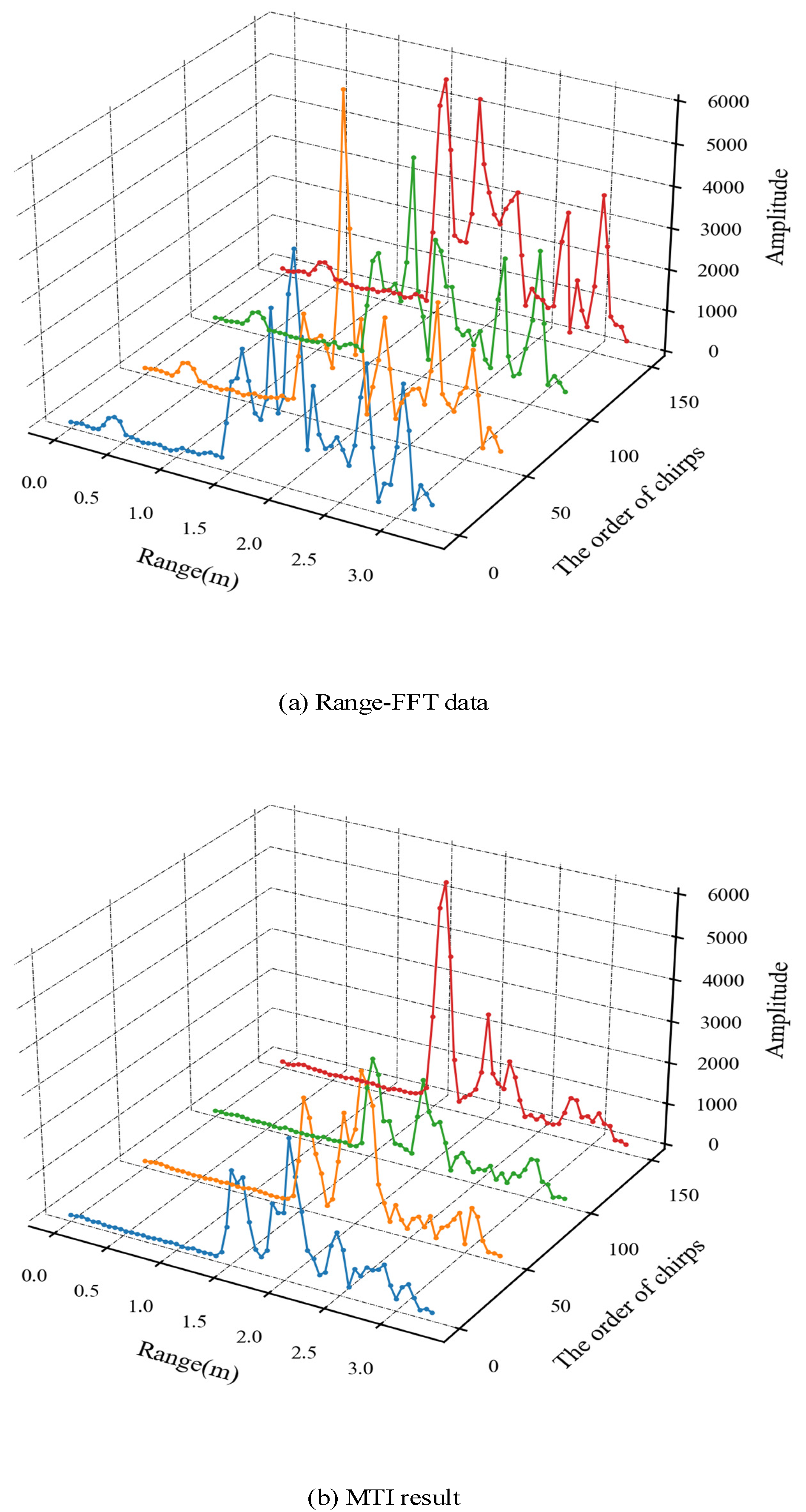
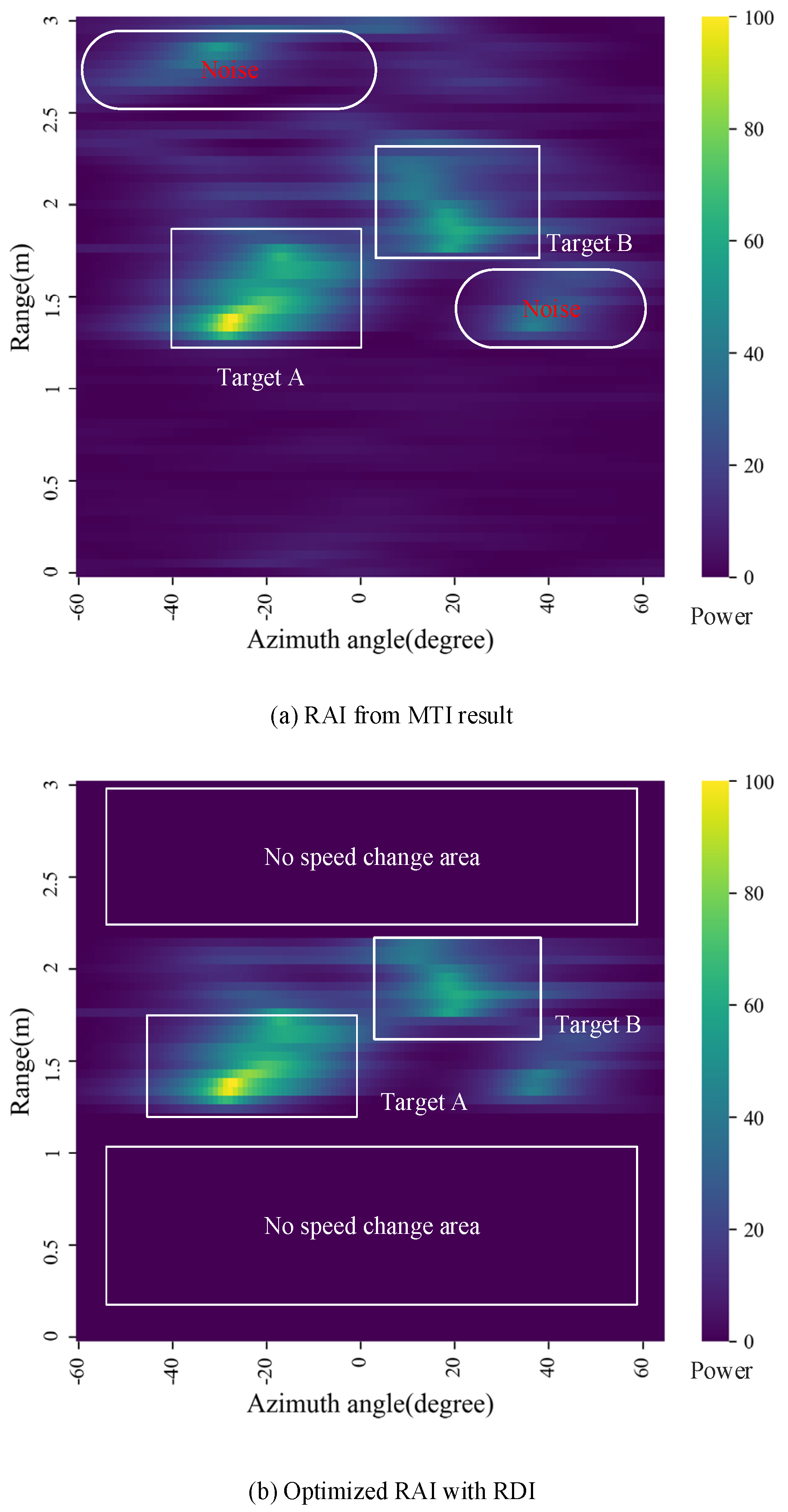
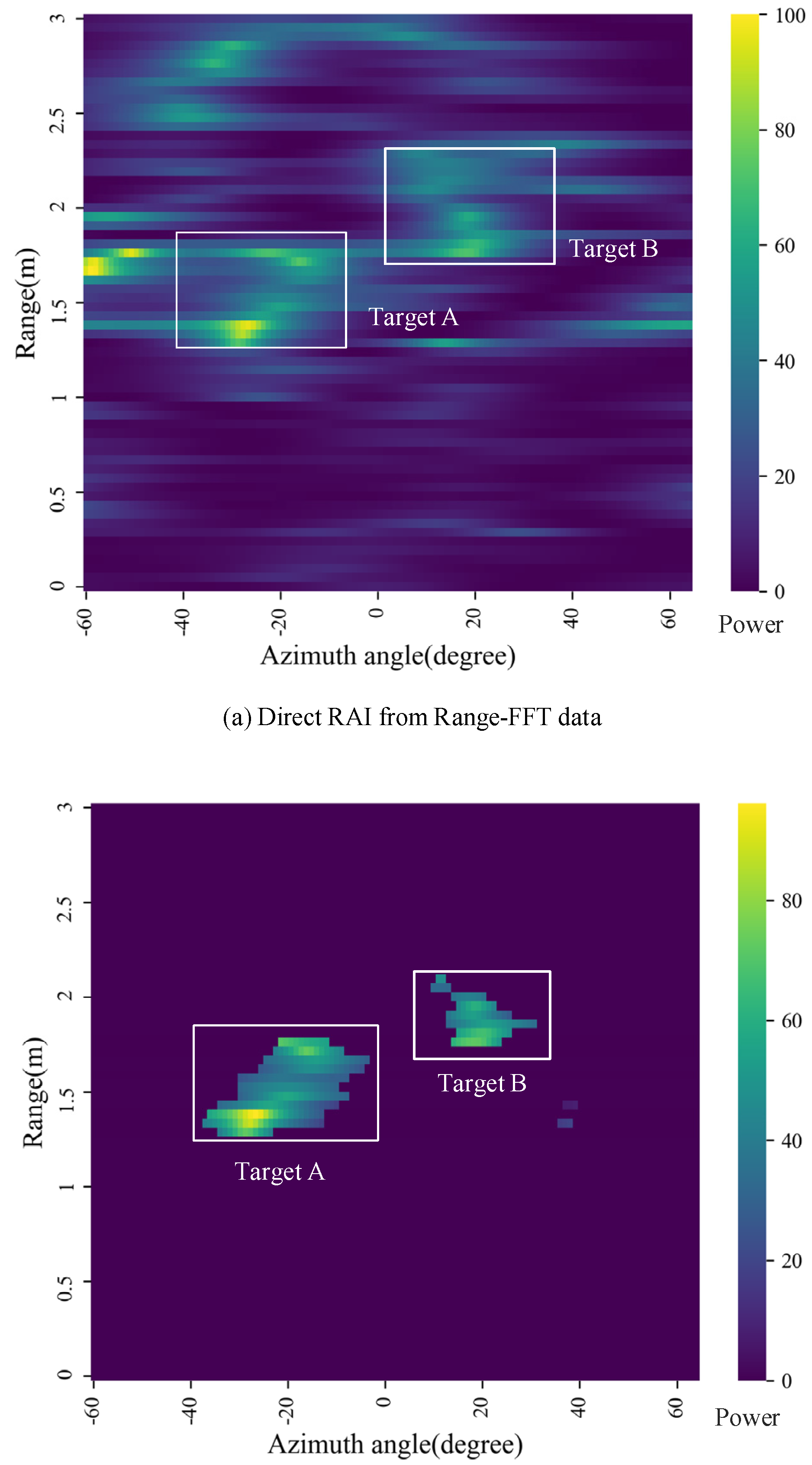
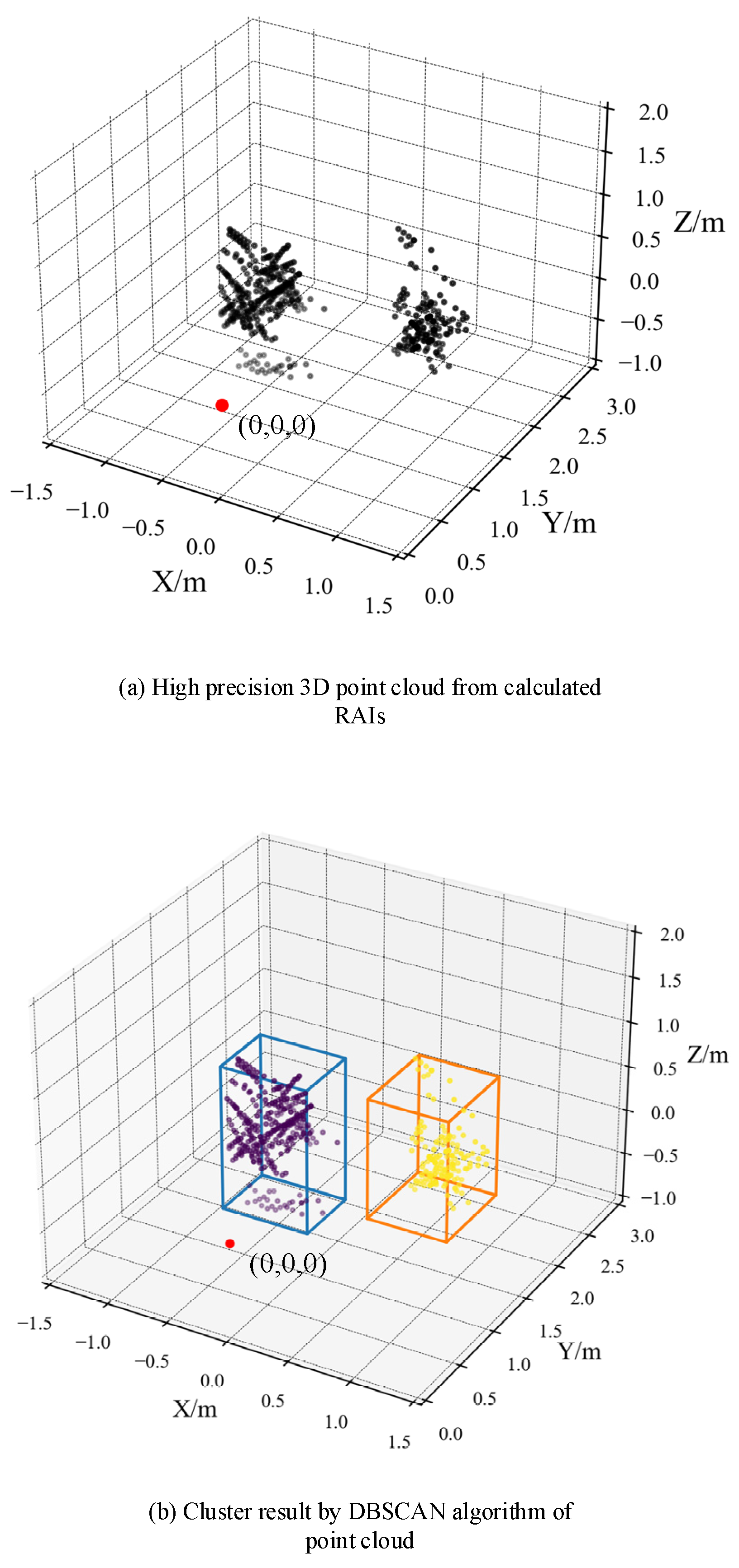
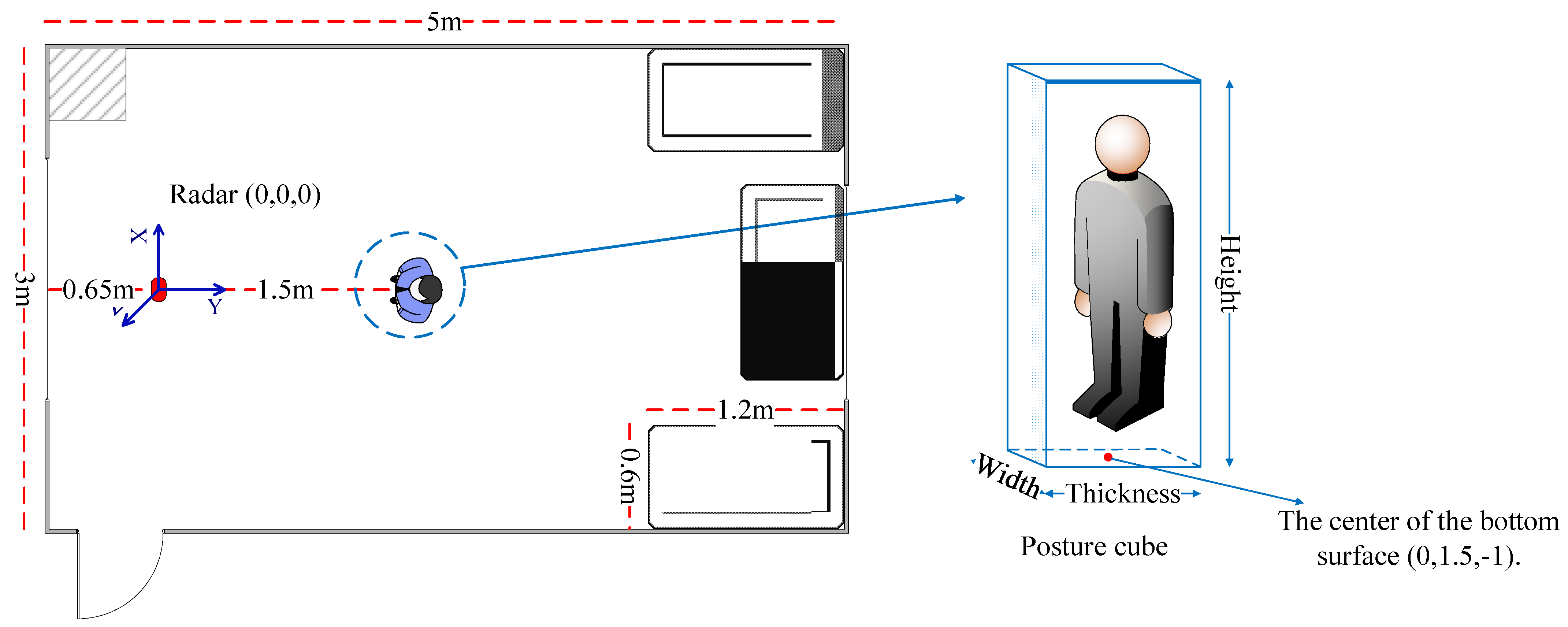
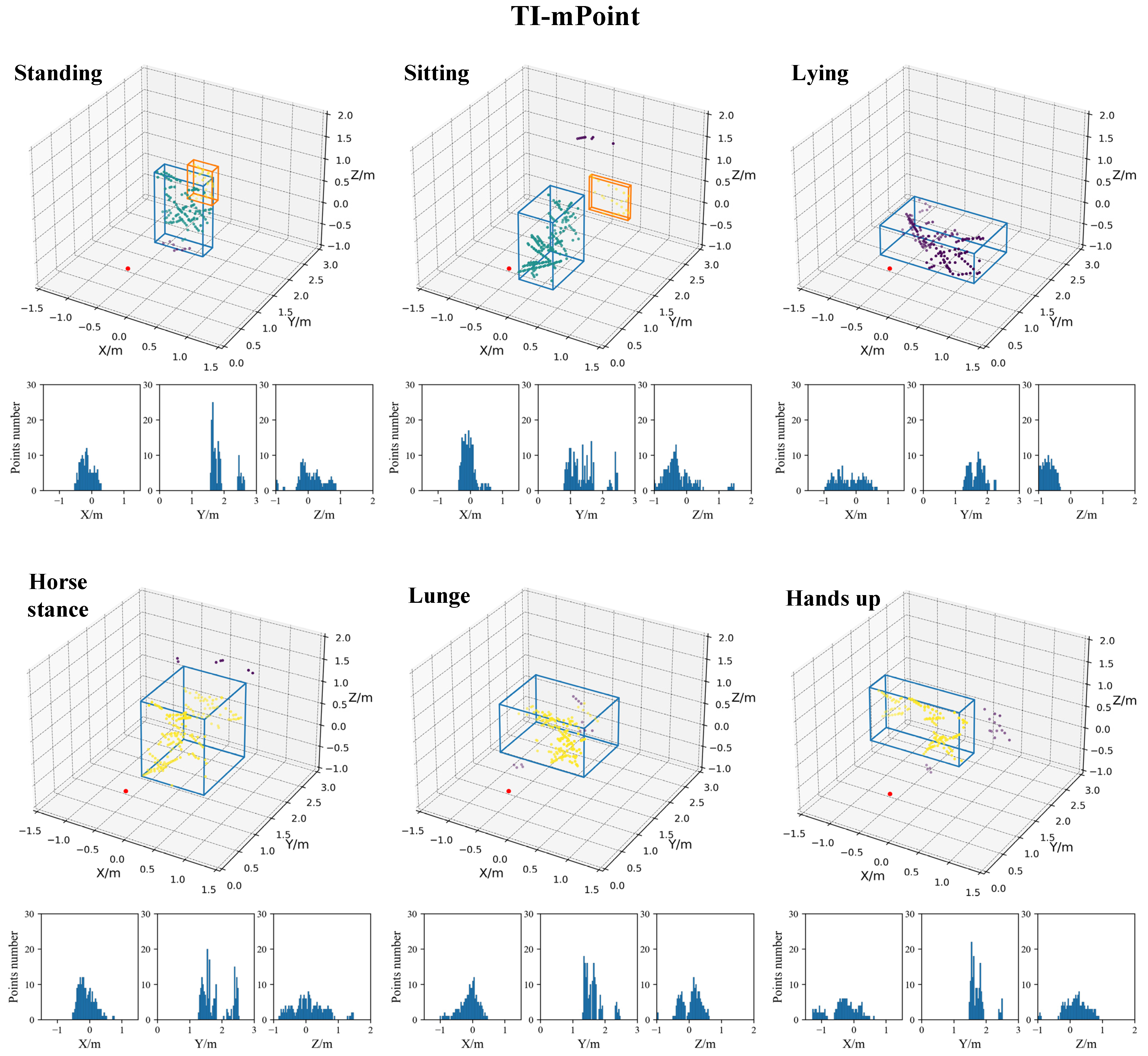
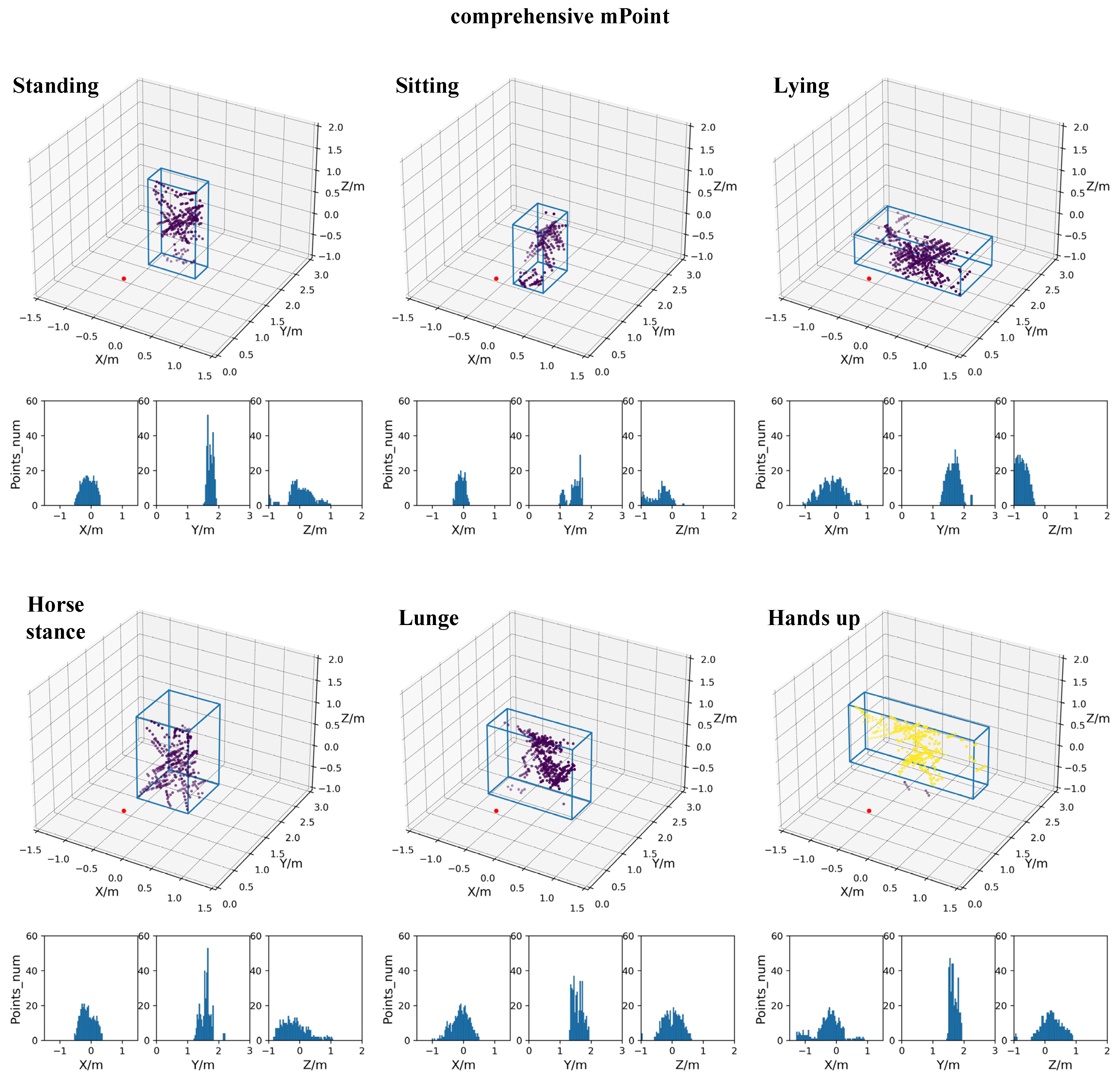
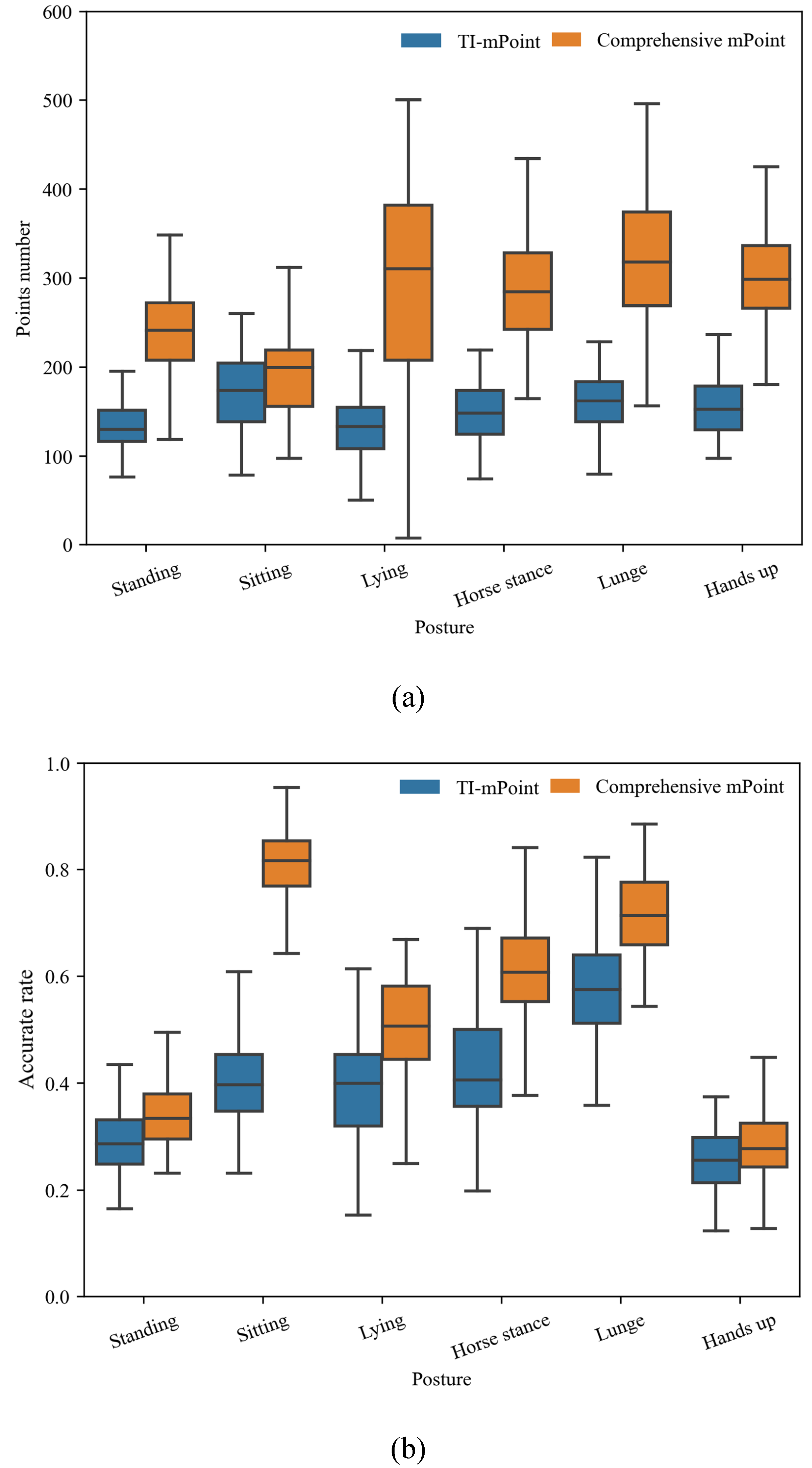
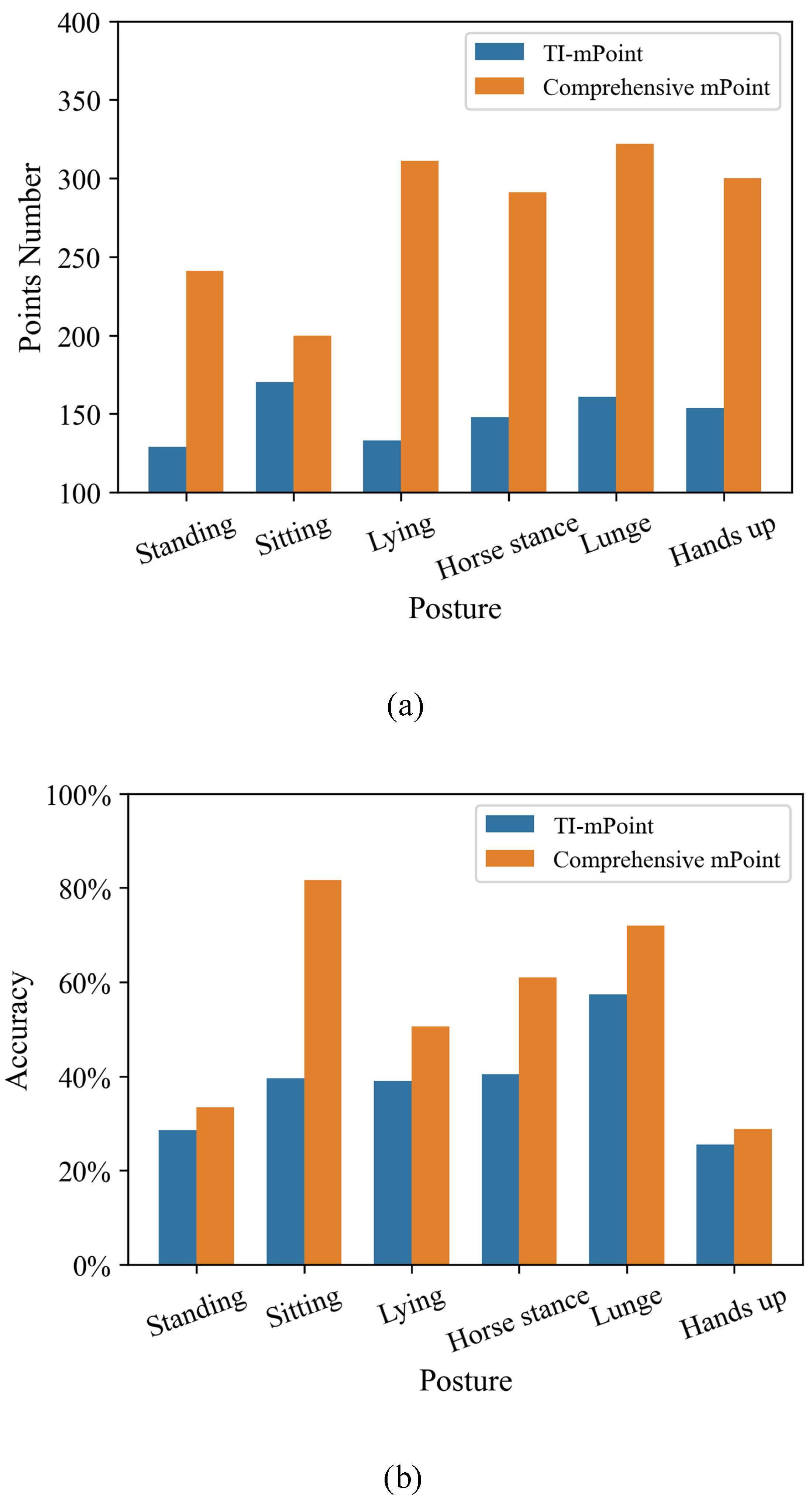
| Parameter | Configuration |
|---|---|
| Start frequency | 60 GHz |
| Sweep bandwidth | 3.92 GHz |
| Sweep slope | 98 MHz/μs |
| Frame rate | 5 fps |
| Sampling frequency | 2200 ksps |
| Number of samples per chirp | 64 |
| Number of chirps per frame | 200 |
| Human Posture | Dimension | ||
|---|---|---|---|
| Height/m | Width/m | Thickness/m | |
| Standing | 1.75 | 0.5 | 0.25 |
| Sitting | 1.28 | 0.55 | 0.65 |
| Lying | 0.7 | 1.45 | 0.48 |
| Horse stance | 1.6 | 0.6 | 0.4 |
| Lunge | 1.6 | 1.23 | 0.35 |
| Hands up | 1.71 | 1.75 | 0.25 |
Publisher’s Note: MDPI stays neutral with regard to jurisdictional claims in published maps and institutional affiliations. |
© 2021 by the authors. Licensee MDPI, Basel, Switzerland. This article is an open access article distributed under the terms and conditions of the Creative Commons Attribution (CC BY) license (https://creativecommons.org/licenses/by/4.0/).
Share and Cite
Zhang, G.; Geng, X.; Lin, Y.-J. Comprehensive mPoint: A Method for 3D Point Cloud Generation of Human Bodies Utilizing FMCW MIMO mm-Wave Radar. Sensors 2021, 21, 6455. https://doi.org/10.3390/s21196455
Zhang G, Geng X, Lin Y-J. Comprehensive mPoint: A Method for 3D Point Cloud Generation of Human Bodies Utilizing FMCW MIMO mm-Wave Radar. Sensors. 2021; 21(19):6455. https://doi.org/10.3390/s21196455
Chicago/Turabian StyleZhang, Guangcheng, Xiaoyi Geng, and Yueh-Jaw Lin. 2021. "Comprehensive mPoint: A Method for 3D Point Cloud Generation of Human Bodies Utilizing FMCW MIMO mm-Wave Radar" Sensors 21, no. 19: 6455. https://doi.org/10.3390/s21196455
APA StyleZhang, G., Geng, X., & Lin, Y.-J. (2021). Comprehensive mPoint: A Method for 3D Point Cloud Generation of Human Bodies Utilizing FMCW MIMO mm-Wave Radar. Sensors, 21(19), 6455. https://doi.org/10.3390/s21196455






